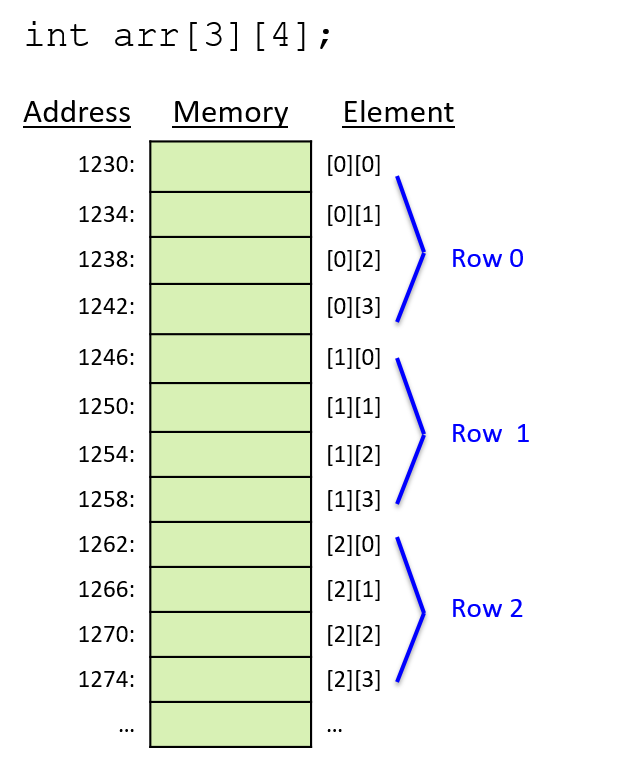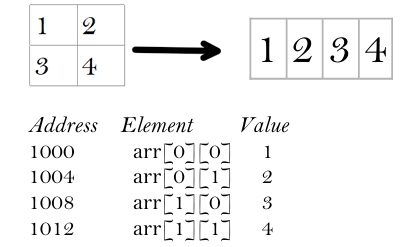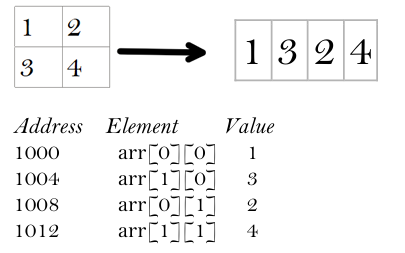MIPS Arrays
Integer Arrays
An Integer Array is continuous storage block in memory in which each element is an integer. Each element of an array is accessed using the base address of the array and the index of the element we must access.
Declaration and Initialization
Integer arrays can be initialized using .word or an empty array can be declared using the .space keyword inside the .data section of the program
data:
arr: .word 3,4,-5,6 #initialized an array arr=[3,4,-5,6]
arr2: .space 40 # empty array with 40 bytes reserved for arr2Array Traversal
Array traversal refers to accessing each element of the array using its index.
Each integer element of an array occupies a word (4 bytes). Therefore,4 bytes needed to be added to the current address to obtain the address of the following element.
Address of arr [k] = base address of arr + 4 * k
Eg: To access arr[3] and store it to $t
a $s0,arr # base add address of array is stored in $s0
addi $s0,$s0,12 # $s0 = address of arr[3] = arr + 4 * 3
lw $t2,0($s0) # $t2=arr[3]or
a $s0,arr # base add address of array is stored in $s0
lw $t2,12($s0) # $t2=value of (arr + 12)Array Input
The elements of an integer array can be received from the user using the syscall for integer input and a for loop.
An empty array must be declared in the .data by allocating the necessary space as shown before.
Each integer element of an array occupies 4 bytes. Therefore, 4 bytes needed to be added to the current address after each insertion.
The following code segment can be used to create an array of size n by receiving inputs from the user:
Assume $s1 contains n, $s0 contains base address of an empty array and $t0 is the loop counter
for:
beq $t0,$s1,exit # loop termination condition
sll $t1,$t0,2 # $t1=i*4
add $t1,$t1,$s0 # $t1 = arr + i * 4
li $v0,5 # input integer and store in $t2
syscall
move $t2,$v0
sw $t2,0($t1) # $t2 = arr[i]
addi $t0,$t0,1 # increment loop counter i
j forPrinting an Integer Array
Integer Array can be printed by traversing each element by using array traversal rules (as discussed above) and integer printing (code 1 is loaded to $v0).
Consider the following code snippet to print the array created in the previous example in which every element is provided by the user:
la $s0,arr # store base address of array in $s0
li $t0,0
print:
beq $t0,$s1,end
sll $t1,$t0,2 # array traversal to access arr[i]
add $t1,$t1,$s0
lw $t2,0($t1) # $t2=arr[i]
li $v0,1 # 1 is the syscall number to print integers
move $a0,$t2 # print $t2
syscall
li $a0, 32 # 32 is the ASCII code for space
li $v0, 11 # syscall number for printing character
syscall
addi $t0,$t0,1 # increment loop counter
j print
end:
li $v0,10 #end program
syscallNegative Numbers as Elements
All integer operations in MIPS support both positive and negative numbers. No changes are required to the program for the input and output of positive integers.
enter array element: -5
enter array element: -6
enter array element: 8
enter array element: -2
The elements of the array are: -5.0 -6.0 8.0 -2.0
-- program is finished running --Floating Point Numbers as Elements
An array of floating-point numbers can be created by replacing all the integer operations with floating-point operations. The following changes need to be made to convert an integer array into an array of floating-point numbers:
- Replace the integer code loaded to $v0 by floating-point code
- Replace the load, store and move operation by l.s , s.s and mov.s where floating point data type is used
# program to input array
for:
beq $t0,$s1,exit
sll $t1,$t0,2
add $t1,$t1,$s0
li $v0,6 # code for floating point input
syscall
s.s $f0,0($t1) # arr[i]=$f0
addi $t0,$t0,1
j for
exit:
# print array
print:
beq $t0,$s1,end
sll $t1,$t0,2
add $t1,$t1,$s0
l.s $f0,0($t1) # $f0=arr[i]
li $v0,2 # code for printing floating point
mov.s $f12,$f0
syscall
li $a0, 32
li $v0, 11
syscall
addi $t0,$t0,1
j print
endOne Dimensional Arrays
To calculate the sum of n numbers in an n sized array
View Code
li $t0,0
la $s0,arr
li $t3,0 #t3 stores the sum
sum: #for loop
beq $t0,$s1,end # $s1 contains n
sll $t1,$t0,2
add $t1,$t1,$s0
lw $t2,0($t1) # $t2=arr[i]
add $t3,$t3,$t2 # $t3=$t3+$t2
addi $t0,$t0,1 # increment loop counter
j sum
end:
li $v0,1 # print sum
move $a0,$t3
syscallTo find the largest element in an n sized array
View Code
la $s0,arr
li $t0,0
li $t3,-1000 # $t3=max
# initialized to -1000
max:
beq $t0,$s1,end # $s1 contains n
sll $t1,$t0,2
add $t1,$t1,$s0
lw $t2,0($t1) # $t2=arr[i]
ble $t2,$t3,inc_i # if arr[i]<=max, jump to inc_count
move $t3,$t2 # if arr[i]>max, max=arr[i]
inc_count:
addi $t0,$t0,1 # increment loop counter
j max
end:
li $v0,1 # print max
move $a0,$t3
syscallTwo Dimensional Arrays
2-DArrays/Matrices/Tables aren’t stored in memory the way it is normally visualized; rather it is stored as a single array in either row major form or column major form. Let’s see how a matrix is represented in memory in both the forms with a starting address of 1230. (Remember:In an array each element is 4 bytes long).
a) Row Major form : Here elements are stored row wise. First we store the first row, then the second and soon.

b) Column Major form: Here elements are stored column wise. First we store the first column, then the second and soon.
Row Major form ( starting address 1000 )

Column Major form ( starting address 1000 )

Sample code
->Insertion of elements and printing the 2D-array
We are using row major form to input the elements as a string
NOTE: all characters need to be space separated, the end of the sequence also need to have a space
Pseudo code
View Pseudo Code
Prompt user for number of rows and columns
Initialize 2D array
Prompt user to enter matrix values as a string
Loop through input string:
- Extract numbers delimited by spaces
- Convert each substring to integer and store in the 2D array
Print the matrix:
- Loop through rows:
- Loop through columns:
- Print each element of the matrix
- Print a space between elements
- Print a newline after each row
Exit the programMIPS Code
View Code
.data
newline: .asciiz "\n"
space: .asciiz " "
msg_rows: .asciiz "Enter number of rows : "
msg_columns: .asciiz "Enter number of columns : "
msg_input: .asciiz "Enter matrix ( row major form ) : "
mat1: .space 100
input: .space 100
.text
main:
li $v0, 4
la $a0, msg_rows
syscall
li $v0, 5
syscall
move $t0, $v0 # $t0 = number of rows
li $v0, 4
la $a0, msg_columns
syscall
li $v0, 5
syscall
move $t1, $v0 # $t1 = number of columns
li $v0, 4
la $a0, msg_input
syscall
li $v0, 8 # syscall for read_str
la $a0, input # Load address of input buer
li $a1, 100 # Maximum length
syscall
la $t2, input
la $t3, mat1
li $t5, 0
# t2 - address of input string
# t3 - address of matrix
# t4 - used to iterate through string
# t5 - used to calculate number
input_loop:
lb $t4, 0($t2)
beq $t4, 32, store
# when a space is detected add the number calculated to the array and continue
beq $t4, $zero , end_input
#In ASCII encoding, the decimal value 32 corresponds to the space character (' ')
#This loop exist to calculate numbers that have more than one digit , since our input is a string.
# We need to iterate and add the characters until we detect a space
sub $t6 , $t4, 48 # converts character to integer
# for calculating the number
mul $t5, $t5, 10
add $t5, $t5, $t6
addi $t2, $t2, 1
j input_loop
store:
sw $t5, 0($t3) #store the number obtained in the 2D-array
addi $t3, $t3, 4 #increment the address to next memory block
li $t5, 0
add $t2 , $t2 , 1 #increment the index of string
j input_loop #loop back to the input to continue iteration of string
end_input :
li $t6 , 0 # Initialize row index
la $t8, mat1 # Load address of array for printing
li $v0, 4
la $a0, newline
syscall
print_loop:
beq $t6 , $t0 , end_programme
li $t7 , 0 # Initialize column index
print_column_loop:
lw $t9 , 0($t8) # Load number from array
li $v0, 1 # syscall for print_int
move $a0, $t9 # Load number to print
syscall
li $v0, 4 # syscall for print_str
la $a0, space # Load address of space
syscall
addi $t7, $t7, 1 # Increment column index
addi $t8 , $t8 , 4 # Increment base address
blt $t7, $t1 , print_column_loop # Print all elements in the row
# Print newline after each row
li $v0 , 4
la $a0 , newline
syscall
# Reset column index for next row
li $t7 , 0
# Increment row index
addi $t6 , $t6 , 1
j print_loop
end_programme :
li $v0, 10 # syscall for exit
syscallOutput
View Output
Enter number of rows:3
Enter number of columns:3
Enter matrix(row major form) : 1 2 3 4 5 6 7 8 9
1 2 3
4 5 6
7 8 9To find maximum and minimum element in a 2-D array
We are using row major form to input the elements as a string
same process of taking the input as the above
NOTE: all characters need to be space separated, the end of the sequence also need to have a space
Pseudo code
View Pseudo Code
Prompt user for number of rows and columns
Initialize 2D array
Prompt user to enter matrix values as a string
Loop through input string:
- Extract numbers delimited by spaces
- Convert each substring to integer and store in the 2D
array
Find minimum and maximum elements in the matrix:
- Initialize minimum element to maximum possible value
and maximum element to 0
- Loop through each element of the matrix:
- Update minimum and maximum elements if necessary
Print the maximum element message:
- Print "The maximum element is: "
- Print the maximum element
Print the minimum element message:
- Print "The minimum element is: "
- Print the minimum element
Exit the programMIPS Code
View Code
.data
newline: .asciiz "\n"
space: .asciiz " "
msg_rows: .asciiz "Enter number of rows : "
msg_columns: .asciiz "Enter number of columns : "
msg_input: .asciiz "Enter matrix ( row major form ) : "
maximum : .asciiz"The maximum element is : "
minimum : .asciiz"The minimum element is :
mat1: .space 100
input: .space 100
.text
main:
li $v0, 4
la $a0, msg_rows
syscall
li $v0, 5
syscall
move $t0, $v0 # $t0 = number of rows
li $v0, 4
la $a0, msg_columns
syscall
li $v0, 5
syscall
move $t1, $v0 # $t1 = number of columns
li $v0, 4
la $a0, msg_input
syscall
li $v0, 8 # syscall for read_str
la $a0, input # Load address of input buer
li $a1, 100 # Maximum length
syscall
la $t2, input
la $t3, mat1
li $t5, 0
# t2 - address of input string
# t3 - address of matrix
# t4 - used to iterate through string
# t5 - used to calculate number
input_loop:
lb $t4, 0($t2)
beq $t4, 32, store
# when a space is detected add the number calculated to the array and continue
beq $t4, $zero , end_input
#In ASCII encoding, the decimal value 32 corresponds to the space character (' ')
#This loop exist to calculate numbers that have more than one digit , since our input is a string
# we need to iterate and add the characters until we detect a space
sub $t6 , $t4, 48 # converts character to integer
# for calculating the number
mul $t5, $t5, 10
add $t5, $t5, $t6
addi $t2, $t2, 1
j input_loop
store:
sw $t5, 0($t3) #store the number obtained in the 2D-array
addi $t3, $t3, 4 #increment the address to next memory block
li $t5, 0
add $t2 , $t2 , 1 #increment the index of string
j input_loop #loop back to the input to continue iteration of string
end_input :
li $t6 , 0 # Initialize row index
la $t8, mat1 # Load address of array for printing
li $v0, 4
la $a0, newline
syscall
find_min_max:
li $t3 , 0 # Initialize max element to 0
li $t2 , 0xffffffff
li $t6 , 0 # Initialize row index to 0
la $a0 , mat1
row_loop:
beq $t6, $t0 , end # If all rows have been checked, exit
li $t7, 0 # Initialize column index to 0
column_loop:
beq $t7, $t1 , end_column_loop # If all columns have been checked, move to next row
lw $t8, 0($a0) # Load current element from array
# Compare current element with max element and the min element
bgt $t8, $t3, update_max # if element greater than max element , update max
min :
blt $t8 , $t2 , update_min # if element smaller than min element, update min
increment :
addi $a0, $a0, 4 # Move to next column
addi $t7, $t7, 1 # Increment column index
j column_loop
update_max:
move $t3 , $t8 # Update max element
j min # control goes back to checking for the conditional statement of min element
update_min:
move $t2 , $t8 # Update min element
j increment # control goes back to incrementing the looping values
End_column_loop:
addi $t6, $t6, 1 # Increment row index
j row_loop
end :
li $v0 , 4
la $a0 , maximum
syscall
li $v0 , 1
move $a0 , $t3 # printing the maximum element
syscall
li $v0 , 4
la $a0 , newline
syscall
li $v0 , 4
la $a0 , minimum # printing the minimum element
syscall
li $v0 , 1
move $a0 , $t2
syscall
li $v0 , 10
syscallOutput
View Output
Enter number of rows :3
Enter number of columns :3
Enter matrix ( row major form ) : 1 2 34 5 6 7 300 9 22
The maximum element is : 300
The minimum element is : 1More Questions
->Searching in Matrix: Write a MIPS assembly program to search for a given element in a matrix and return its position if found.
->Matrix Addition: Write a MIPS program to add two matrices of the same size
->Transpose of a Matrix: Write a MIPS assembly program to find the transpose of a given matrix.
